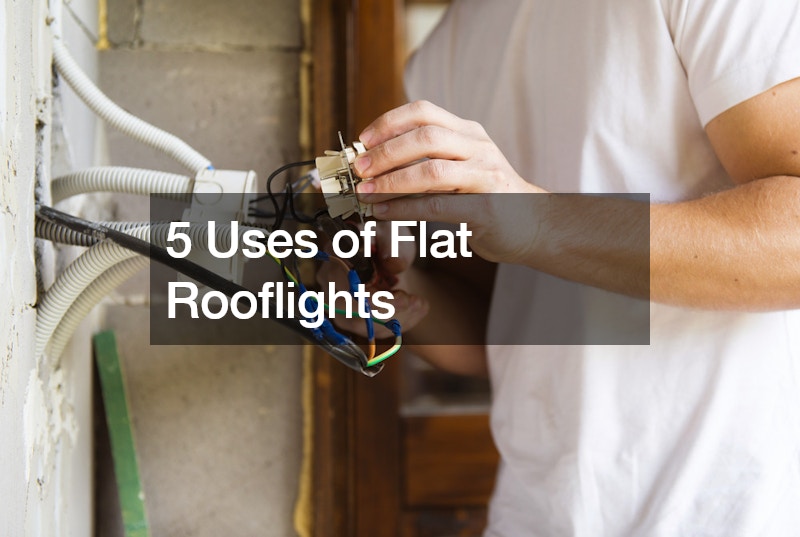
In the realm of architectural design, the quest for natural light has led to the emergence of innovative solutions that blur the boundaries between indoor and outdoor spaces. Among these, flat rooflights stand out as versatile and elegant features, offering a seamless integration of daylight into a variety of architectural contexts. From residential dwellings to commercial complexes, these sleek and modern installations serve as both practical solutions and aesthetic enhancements.
In this article, we delve into five compelling uses of flat rooflights and their transformative impact on modern architecture.
1. Residential Skylights
In residential architecture, flat rooflights serve as stylish and functional skylights that bring natural light into interior spaces. Whether installed in living rooms, kitchens, or bedrooms, these luminous features create an airy and spacious atmosphere, enhancing the overall quality of living for occupants. By strategically positioning flat roof lights, architects can illuminate previously dim and secluded areas, transforming them into vibrant and inviting spaces flooded with daylight.
Moreover, flat rooflights offer homeowners the opportunity to connect with the outdoors while maintaining privacy and security. With their sleek and discreet profiles, these installations provide unobstructed views of the sky and surrounding environment, fostering a sense of openness and tranquility within the home. Additionally, flat rooflights can be equipped with integrated blinds or shading systems to regulate sunlight and enhance thermal comfort, ensuring optimal living conditions year-round.
2. Commercial Atriums
In commercial architecture, flat roof lights play a crucial role in the design of atriums and large communal spaces. These expansive installations create dramatic focal points that draw natural light deep into the heart of a building, illuminating interior spaces with a soft and diffuse glow. By introducing daylight into atriums, lobbies, and reception areas, flat rooflights enhance the visual appeal of commercial buildings while providing occupants with a connection to the outdoors.
Furthermore, flat roof lights contribute to the sustainability and energy efficiency of commercial spaces by reducing the need for artificial lighting during daylight hours. By harnessing natural light, businesses can lower energy consumption and operational costs while creating a more pleasant and productive environment for employees and visitors alike. Additionally, the aesthetic allure of flat rooflights adds a touch of sophistication and modernity to commercial interiors, reinforcing the brand identity and architectural character of the space.
3. Educational Facilities
In educational settings, flat roof lights offer a practical solution for bringing natural light into classrooms, libraries, and common areas. These installations create bright and inviting learning environments that promote student engagement, focus, and well-being. By maximizing daylight penetration, flat roof lights help reduce reliance on artificial lighting, creating energy-efficient and sustainable educational facilities.
Moreover, flat roof lights contribute to the architectural design of educational buildings, enhancing their visual appeal and functionality. Whether integrated into modern school buildings or retrofitted into historic structures, these luminous features add a contemporary touch while preserving the historical integrity of the architecture. Additionally, the introduction of natural light into educational spaces has been shown to positively impact student performance, behavior, and overall academic achievement, making flat rooflights a valuable asset in the design of schools and universities.
4. Hospitality Venues
In the hospitality industry, flat rooflights create captivating environments that elevate the guest experience and reinforce the brand identity of hotels, restaurants, and bars. These luminous installations serve as focal points that enhance the ambiance and atmosphere of hospitality venues, creating memorable settings for patrons to relax, socialize, and enjoy their surroundings.
Whether installed in hotel lobbies, dining areas, or spa facilities, flat roof lights create a sense of openness and spaciousness, blurring the boundaries between indoor and outdoor spaces. By flooding interior areas with natural light, these installations create a warm and inviting atmosphere that encourages guests to linger and explore. Additionally, the aesthetic versatility of flat roof lights allows designers to customize their appearance to suit the theme and décor of the venue, whether it be sleek and modern or rustic and charming.
5. Retail Environments
In retail design, flat roof lights play a vital role in creating dynamic and visually engaging shopping experiences for customers. These luminous features provide abundant natural light that highlights merchandise, enhances displays, and creates a welcoming ambiance within retail spaces. By illuminating product showcases and storefronts, flat roof lights draw attention to key focal points and encourage foot traffic, ultimately driving sales and boosting revenue for retailers.
In conclusion, flat roof lights represent a versatile and innovative solution for bringing natural light into a variety of architectural spaces. From residential dwellings to commercial complexes, these sleek and modern installations enhance the quality of living and working environments while promoting sustainability and energy efficiency. As architects and designers continue to explore the possibilities of flat rooflights in shaping the built environment, their transformative impact on modern architecture will undoubtedly continue to inspire awe and admiration for years to come.
.


